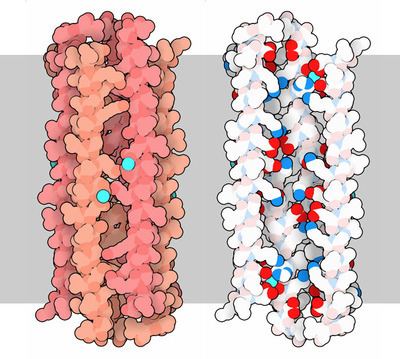Entrez 117159 | Ensembl ENSG00000161634 | |
 | ||
Aliases DCD, AIDD, DCD-1, DSEP, HCAP, PIF, dermcidin External IDs OMIM: 606634 HomoloGene: 89039 GeneCards: DCD | ||
Dermcidin, also known as proteolysis-inducing factor (PIF), is a protein that in humans is encoded by the DCD gene. It is an anti-microbial peptide secreted by human eccrine sweat glands onto the skin as a part of the innate host defense of the immune system. It is also involved in proteolysis.
Contents
A movie of ion conduction across dermcidin
Function
Dermcidin is a secreted protein that is subsequently processed into mature peptides of distinct biological activities. The C-terminal peptide is constitutively expressed in sweat and has antibacterial and antifungal activities. The N-terminal peptide, also known as diffusible survival evasion peptide, promotes neural cell survival under conditions of severe oxidative stress. A glycosylated form of the N-terminal peptide may be associated with cachexia (muscle wasting) in cancer patients.
Survival evasion peptide Antimicrobial peptideYDPEAASAPGSGNPCHEASAAQKENAGEDPGLARQAPKPRKQRSSLLEKGLDGAKKAVGGLGKLGKDAVEDLESVGKGAVHDVKDVLDSVLThe C-termial precursor DCD-1L is a 48 residue peptide that shows partial helicity in solution, as evidenced by the determination of its solution structure by NMR and CD-spectroscopy. The full length precursor is processed by undetermined proteases present in human sweat, to form several shorter peptides that show variable antimicrobial activity, named according to their C-terminal triplet of amino acids and their resiude length. One such active peptide is SSL25, which shows a 2-fold increase in activity against E.coli compared to DCD-1L.
DCD-1L SSLLEKGLDGAKKAVGGLGKLGKDAVEDLESVGKGAVHDVKDVLDSVLDCD-1 SSLLEKGLDGAKKAVGGLGKLGKDAVEDLESVGKGAVHDVKDVLDSVSSL25 SSLLEKGLDGAKKAVGGLGKLGKDAMechanism
The crystal structure of dermcidin has been solved in solution to reveal a hexameric helix-bundle, mediated by Zn ion binding. This is observed to form a tilted channel in membranes under computational examination by molecular dynamics simulations, and one suggested mechanism of antimicrobial action inferred from this observation is by ion gradient decoupling across biological membranes. This is supported by concurrent observations in experimental studies of a voltage dependent depolarization of lipid bilayers.
